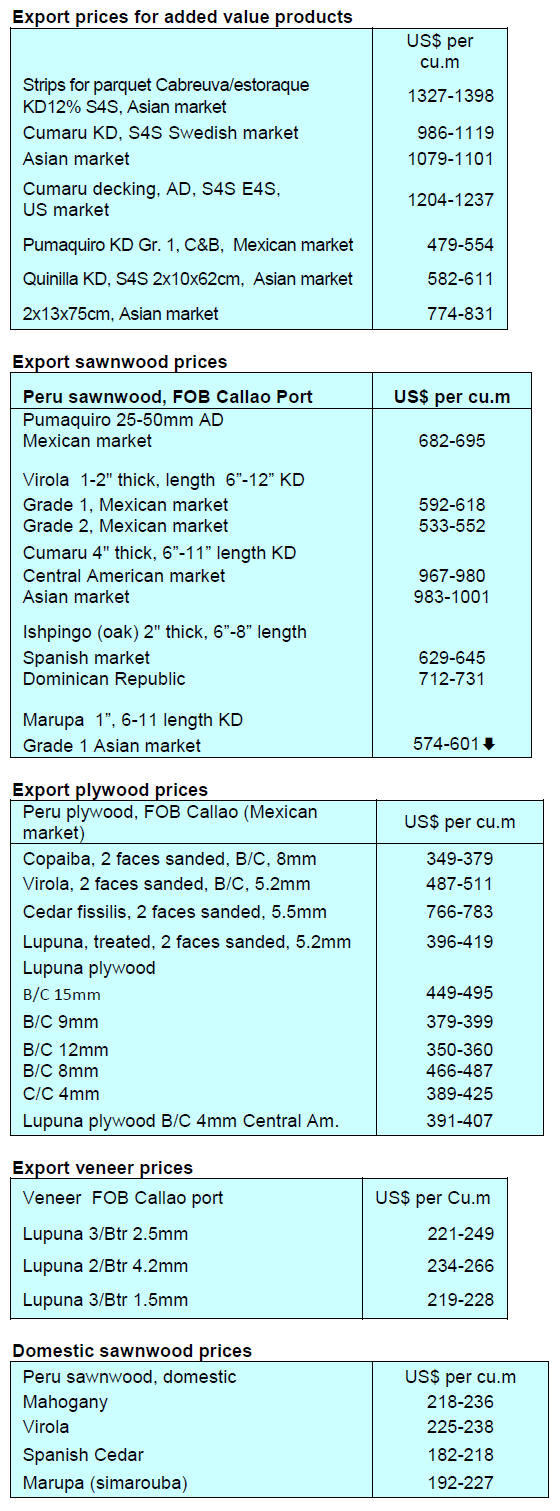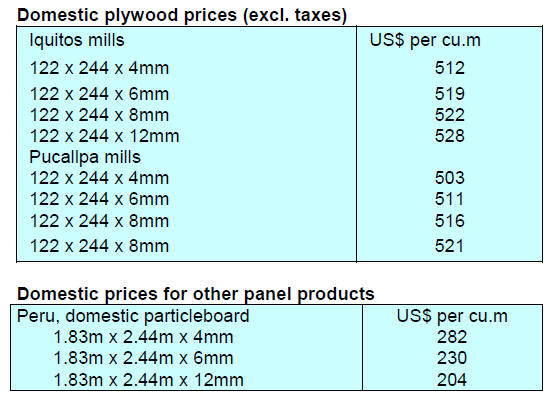4.
INDONESIA
Lightwood-Hub creates new
opportunities
The Association of Indonesian Forest Concession Holders (APHI)
welcomed the new ‘Lightwood-Hub’ to promote lightwood for building
construction. The chairman of APHI, Indroyono Soesilo, stated that,
currently, the world is entering the era of a Green Economy including the
building of ‘Green Buildings’ which use a lot of wood products in the
construction process.
To further encourage the use of light wood Indroyono stressed the need for
synergy between three parties; forestry businesses as providers of wood raw
materials, architects as designers of buildings with light wood materials
and construction engineers who understand how to use wood.
Indroyono also called on APHI members to be more courageous in exploring
opportunities to use lightwood.
See:
https://forestinsights.id/2023/05/12/aphi-sambut-kehadiran-lightwoodhub-buka-potensi-pasar-kayu-rimba-campuran/
First Quarter 2023 furniture exports
Furniture exports earned US$501 million in the first quarter of
2023. The Director General of Agro Industries in the Ministry of Industry,
Putu Juli Ardika, said the expansion of furniture exports was reflected in
the Industrial Confidence Index (IKI) which reached a level of 51.38 in
April 2023 signaling expansion.
The Ministry of Industry has implemented several policies to support the
growth of the furniture industry including facilitating the ‘Raw Material
Logistics Center’ in an effort to improve the supply of raw materials for
the furniture industry, the establishment of the ‘Furniture and Wood
Processing Polytechnic’ in Kendal to train workers for the furniture
industry, the machine/equipment restructuring programme for the wood
processing industry and empowerment of SMEs through SMEs centers.
See: https://akurat.co/furnitur
and
https://www.viva.co.id/siaran-pers/1599690-kemenperin-upayakan-industri-furnitur-terus-berekspansi?page=all
In related news, the Minister for Cooperatives and Small and Medium
Enterprises, Teten Masduki, has urged furniture and craft manufacturers to
seek new alternative markets in response to changes in traditional markets.
He noted that over the next few years the sector has to target alternative
markets, not just America and Europe. Echoing this sentiment, Agro-Industry
Director General, Putu Juli Ardika, said Indonesian furniture products are
frequently exported to Europe and the United States, which are currently
experiencing economic stagnation.
He reported that an export task force has been formed and it is currently
investigating new markets for furniture one of which would be member
countries of ASEAN, Middle Eastern countries and non ASEAN Asian countries.
See:
http://bisnisbali.com/industri-furnitur-lokal-didorong-bidik-pasar-ekspor-alternatif/
Interzum 2023 exhibition
Indonesian wood products recorded potential transactions worth
US$3.1 million at the May Interzum 2023 exhibition. Didi Sumedi, Director
General of National Export Development in the Ministry of Trade said that
Indonesian wood products are appreciated by European consumers because of
the quality and style.
The Acting Director of Manufacturing Export Development, Ganef Judawati,
added that the exhibition was a prestigious international event that
attracted around 70,000 visitors and exhibitors and became a business
opportunity for around 1,800 exhibitors from Europe, Asia and America.
In 2022, exports of Indonesian wood products to
Germany were recorded at US$95 million, down 4% compared to the previous
year. Meanwhile, exports of Indonesian wood products to the European Union
in 2022 were recorded at US$389 million, down 3% in 2022 compared to 2021.
See:
https://swa.co.id/swa/trends/economic-issues/produk-kayu-olahan-ri-mampu-bukukan-transaksi-rp-46-miliar-di-pasar-eropa
Strategies for sustainable forest management
The Indonesian government presented three strategies for
sustainable forest management on the first day of the 18th session of the
United Nations Forum on Forests (UNFF18) at the United Nations (UN)
Headquarters.
The Director General of Sustainable Forest Management Ministry Environment
and Forestry (KLHK), Agus Justianto, mentioned Indonesia's three
contributions to realising the United Nations Strategic Plan for Sustainable
Forest Management. Implementation of Indonesia's FOLU Net Sink 2030 agenda,
implementation of multi-business forestry and the active involvement of
communities in forest management through the Social Forestry programme.
On the multi-business forestry scheme utilisation is no longer focused only
on wood but also on optimising the potential of non-timber forest products,
ecotourism and environmental services.
See:
https://www.antaranews.com/berita/3529572/indonesia-paparkan-strategi-pengelolaan-hutan-lestari-dalam-sidang-pbb
and
https://www.msn.com/id-id/berita/nasional/klhk-beberkan-3-kontribusi-indonesia-wujudkan-rencana-pbb-untuk-pengelolaan-hutan/ar-AA1aYtKu
President seeks forestry partnership with Brazil
On the sidelines of the G7 Summit President Joko Widodo sought a
strengthened partnership between Indonesia and Brazil on forestry. Forestry
related issues are a priority for both countries as Indonesia and Brazil are
among the countries with the largest area of tropical forests.
The two leaders came to an agreement to convince developed countries to
realise their commitments to provide funds for tackling issues related to
climate change.
See:
https://en.antaranews.com/news/282333/president-seeks-to-intensify-forestry-partnership-with-brazil
Indonesia and EU complete 14th IEU-CEPA negotiations
Indonesia and the European Union (EU) completed the 14th round of
the Indonesia-EU Comprehensive Economic Partnership Agreement (IEU-CEPA)
negotiation in Brussels, from May 8–12, 2023. According to a statement
published the two parties managed to achieve significant progress on the
development of the agreement in the negotiation round.
The Director of Bilateral Negotiations at the Indonesian Ministry of Trade,
Johni Martha, has been reprted as saying with this progress we are
optimistic that we can achieve the determined targets in this negotiation
process.
18 substantive primary issues were negotiated in the 14th round including
trade in goods, rules of origin, trade in services, trade security,
investment, government procurement, transparency and regulatory practice,
dispute resolution, institutional provisions as well as intellectual
property rights.
Other issues discussed were state-owned enterprises, economic cooperation
and capacity building, investment court system, subsidies, anti-fraud
policies, energy and raw materials, small and medium enterprises as well as
trade technical barriers.
See:
https://en.tempo.co/read/1725637/indonesia-eu-complete-14th-ieu-cepa-negotiations-round
Strengthening economic fundamentals
Indonesia continues to strengthen economic fundamentals in support
of economic growth according to the Minister of Finance, Sri Mulyani
Indrawati, In the post pandemic era Indonesia is focusing on how to
strengthen economic fundamentals.
The Minister explained that, even during the pandemic, Indonesia continued
highly ambitious reforms, including the tax harmonisation law, alignment of
central and regional fiscal policies, financial sector reform and a job
creation law. Financial sector reforms included the integration and adoption
of financial technology (fintech), strengthening efforts for small and
medium enterprises (SMEs) and consumer data protection.
See:
https://en.antaranews.com/news/281208/indonesia-continues-to-reform-to-boost-economic-fundamentals-minister
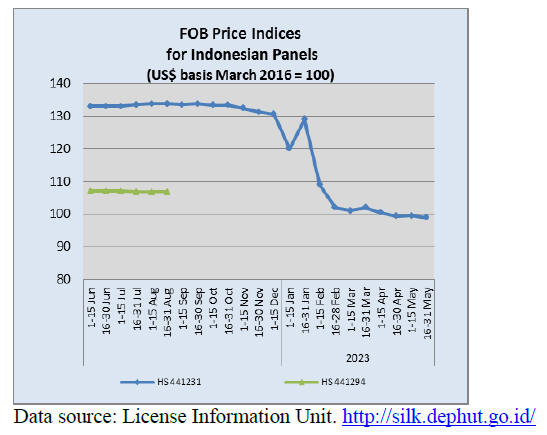
Through the eyes of industry
The latest GTI report lists the challenges identified by the private sector
in Indonesia.
https://www.itto-ggsc.org/list_52/439.html
5.
MYANMAR
-
6.
INDIA
High interest rates and weak
international demand could dampen prospects for exports
India's economy is projected to expand by almost 6% in 2023 driven
mostly by domestic demand according to the latest UN World Economic
Situation and Prospects report. However, high interest rates and weakening
international demand could dampen prospects for exports and investment.
See:
https://www.livemint.com/economy/indias-economy-backed-by-domestic-demand-but-high-cost-of-funds-hinders-investments-un-report-11684340454975.html
Wood products price indices
The annual rate of inflation based on all India Wholesale Price
Index (WPI) in April was 0.92% compared to 1.34% recorded in March 2023. The
decline in the rate of inflation in April 2023 was mainly due to a fall in
prices of basic metals, food products, mineral oils, textiles, non-food
articles, chemical products, rubber and plastic products and paper.
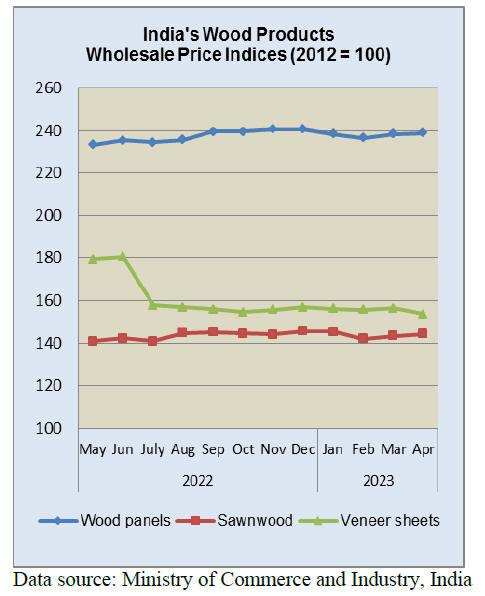
Out of the 22 NIC two-digit groups for manufactured
products, the price index for 14 groups increased while for 8 groups there
was a decline. Some of the groups that recorded a drop in prices were
chemicals; basic metals; food products; fabricated metal products (except
machinery and equipment) leather and related products; paper and paper
products.
See:
https://eaindustry.nic.in/pdf_files/cmonthly.pdf
EU and India Trade and Technology Council (TTC)
A press release from the EC has announced the first meeting of the
new trade council which is seen key deepen the strategic partnership on
trade and technology. The TTC is a coordination platform to address key
trade, technology and security challenges.
The ministerial meeting reviewed the work of three workings groups:
Strategic technologies, digital governance and digital connectivity
Green and clean energy technologies
Trade, investment and resilient value chains
The EU and India enjoy a robust trading relationship. The EU is India's 2nd
largest trading partner accounting for Eur120 billion worth of trade in
goods in 2022 or 10.8% of total Indian trade. India is the EU's 10th largest
trading partner accounting for 2% of EU total trade in goods. Trade in
services between the EU and India reached Eur40 billion in 2021.
See:
https://ec.europa.eu/commission/presscorner/detail/en/ip_23_2728
2,000 rupee notes to be removed from circulation
The Reserve Bank of India has announced it will take out of
circulation its highest denomination currency note, the ,2000-rupee note.
The 2,000 rupee notes were introduced immediately after the demonetisation
exercise. This move will affect small businesses in many sectors and could
be a major challenge for these businesses.
See:
https://www.rbi.org.in/Scripts/NotificationUser.aspx?Id=12506&Mode=0
Heatwave in parts of north and central India
Only towards the end of May did the heat wave in parts of northwest
India ease. With temperatures rising to 45 Celsius the Meteorological
Department (IMD) issued heatwave warnings over Delhi-NCR and adjoining
areas. However, the IMD indicated that the worst of the hot weather had
passed by 24 May with the arrival of light rain and cloudy weather.
See:
https://indianexpress.com/article/india/india-heatwave-weather-update-may-22-8621988/

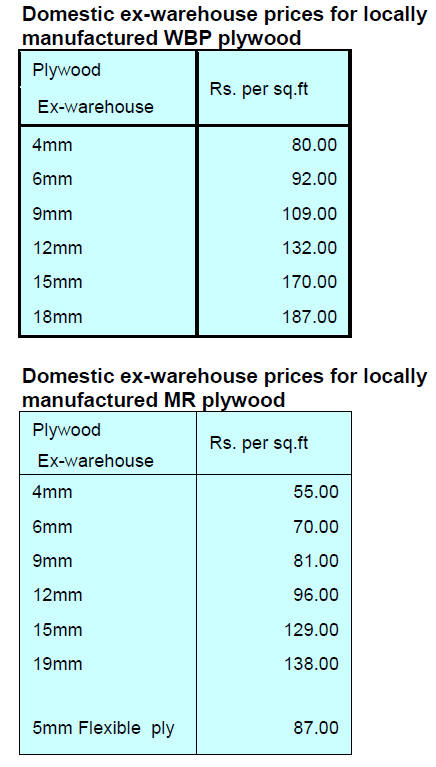
JICA loan for forestry
On behalf of Japan, JICA signed a loan agreement with the Government of
India to provide loans of up to a total of Yen 426,814 million for four
projects, one of which is for Forest and Biodiversity Conservation for
Climate Change Response in West Bengal.
The object of this forestry project is to mitigate and adapt to climate
change, conserve, and restore ecosystems by ecosystem-based climate change
measures, biodiversity conservation and restoration, livelihood improvement
activities and institutional strengthening thereby contributing to
sustainable socio-economic development in West Bengal. The Executing Agency
will be the Department of Forests, Government of West Bengal.
See:
https://www.jica.go.jp/english/news/press/2022/20230329_33.html
7.
VIETNAM
Highlights of Wood & Wood Product
(W&WP) Trade
According to the General Department of Customs in April 2023 W&WP exports
were valued at US$1.09 billion, down 4.3% compared to March 2023 and down
32% year-on-year.
In particular WP exports stood at US$777 million, up 0.5% compared to March
2023 but down 33% compared to April 2022.
In the first 4 months of 2023 W&WP exports amounted to US$3.9 billion, down
31% over the same period in 2022. The WP exports alone accounted for US$2.6
billion, down 38% over the same period in 2022.
W&WP exports to the Japanese market in April 2023 were valued at US$126.9
million, down 17% compared to April 2022. In the first 4 months of 2023 W&WP
exports to Japan reached US$556.3 million, up 1.8% over the same period in
2022.
In April 2023 Vietnam’s exports of kitchen furniture were valued at US$82
million, down 40% compared to April 2022. In the first 4 months of 2023
exports of kitchen furniture reached US$295 million, down 34% year-on-year.
W&WP imports into Vietnam in April 2023 stood at US$169.1 million, down 13%
compared to March 2023 and down 39% compared to April 2022.
Vietnam's W&WP exports to South Korea in April 2023 were valued at US$66
million, down 39% compared to April 2022. Over the first 4 months of 2023
W&WP exports to South Korea totalled US$273.5 million, year-on-year down
23%.
Vietnam’s wood pellet exports in April 2023 earned US$60 million, down 27%
compared to April 2022. In the first 4 months of 2023 wood pellet exports
generated US$260 million, year-on-year rise of 10%.
Wood raw material imported into Vietnam from Southeast Asia in April 2023
stood at 71,000 cu.m, worth US$21.0 million, down 17% in volume and down 14%
in value compared to March 2023.
The total amount imported from this source into Vietnam in the first 4
months of 2023 stood at 248,580 cu.m valued at US$73.5million, down 18% in
volume and 30% in value compared to the same period in 2022.
Vietnam’s W&WP exports to Japan
The main products exported to Japan in the first 3 months of 2023 were wood
chips (US$428.5 million, year-on-year up 8.8%), followed by wood pellets
(US$98.8 million, up 42% over the same period in 2022).
Vietnam is emerging as a top supplier of wood chips and pellets to Japan.
The pace of growth in wood pellet exports from Vietnam to Japan, is
declining. In contrast, Japan’s imports of wood pellets from the US have
been rising. Japan consumes around 30-35% of the woodchips produced in
Vietnam.
After chips and pellets is wooden furniture. In the first 3 months of 2023
wooden furniture shipped to Japan from Vietnam was valued at US$98.8
million, down 26% year-on-year.
Wooden chair frames were the top export item at US$25.8 million, down 15%,
followed by living and dining room furniture, US$25 million, down 39%,
bedroom furniture US$22.8 million, down 11%.
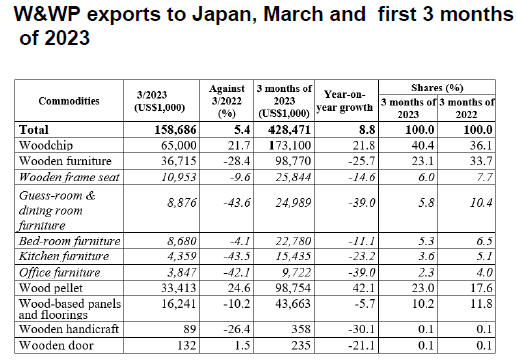
Vietnam’s imports of tali decreasing
With a supply of 89,000 cu.m (worth US$36.1 million) Cameroon accounted for
a 73% share of total imports of tali in the first 3 months of 2023.
According the General Department of Customs, Vietnam's imports of tali from
all sources in April 2023 totalled 32,400 cu.m worth US$13.6 million, down
12% in volume and 13% in value compared to March 2023. Compared to April
2022 imports decreased by 24% in volume and 23% in value.
In the first 4 months of 2023, tali wood imports reached 158,500 cu.m worth
US$65.3 million a year-on-year drop of 8% in volume and 7% in value.
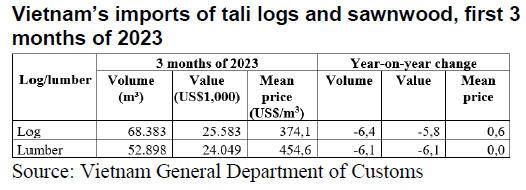
The average price of tali imported into Vietnam in
the first 3 months of 2023 reached US$409/cu.m, a slight increase over the
same period in 2022. In particular, the price for tali imported from Congo
increased by 10% over the same period in 2022 to US$481/cu.m.
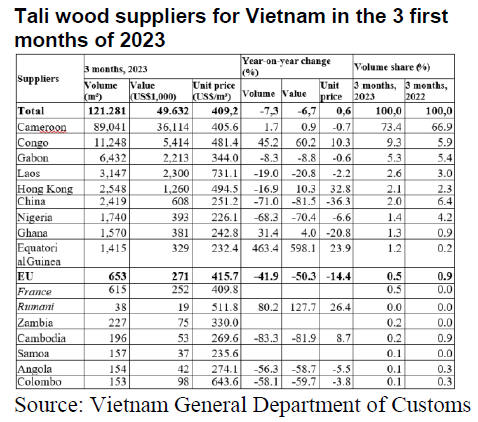
Vietnam’s imports of wood raw material from
Southeast Asia dropping sharply
In the first quarter of 2023 imports of wood raw material from Southeast
Asia to Vietnam amounted to 95,080 cu.m, worth US$18.55 million, down 14% in
volume and down 28% in value over the same period in 2022.
Supply by country
In the first quarter of 2023 Vietnam imported mainly particleboard,
fibreboard and sawnwood from Thailand. Imports of particleboard and
fibreboard decreased significantly over the same period in 2022 with
particleboard imports falling 21% in volume and 44% in value. Fiberboard
imports were down by 41% in volume and 50% in value. Sawnwood imports soared
by 200% in volume and 100% in value in the same period.
In the first quarter of 2023 imports of wood raw material from Laos to
Vietnam amounted to 49,800 cu.m worth US$24,475 million, down 12% in volume
and 24% in value over the same period in 2022.
Logs and sawnwood were the two main wood categories imported from Laos in
the first quarter of 2023. While sawnwood imports from Laos decreased by 15%
in volume and 25% in value compared to the same period in 2022, log imports
increased by 24% in volume and 13% in value.
The volume of wood raw material imported from Malaysia and Indonesia to
Vietnam in the first quarter of 2023 increased sharply compared to the same
period in 2022, up 89% and 67%, respectively.
The wood products imported from the Malaysia were sawnwood, logs and
particleboard while from Indonesia the increased imports relied on flooring,
particleboard and sawnwood.

Vietnamese timber exporters facing a sharp
decline in orders
Vietnamese wood and wooden furniture enterprises have been facing many
difficulties as export orders have dropped 50-60% since the beginning of
this year, pushing firms to cut off at least half of their production
capacities. Data from the General Department of Customs showed that the
export turnover of wood and wooden products reached US$3.9 billion in the
first four months, down 30.6% year-on-year. The export of wooden goods saw a
yearly decline of 38% to $2.6 billion.
At the same time, the import value of wood and wooden products also
decreased significantly to US$634 million, down 33.6% over the same period
last year.
During the four months, Vietnamese exports of these goods to major markets
all decreased sharply such as the US (US$2.02 billion, 38%); Japan US($556
million, 1.5%); South Korea (US$274 million, 22%) and China (US$481 million,
13%).
Analysts and businesses have said that the decrease in wood and wooden goods
exports was foreseeable. They attribute the decline to inflation surges in
some countries, which were also major importers of Vietnam's wood and wooden
goods, resulting in sluggish demand for these products. For example, the US
imported US$1.24 billion worth of timber and wooden products from Vietnam in
the first three months, a year-on-year drop of 42%.
In the context of inflation and the banking crisis, US banks have tightened
credit, making importers unable to finance import goods in large quantities.
The demand for US wooden furniture imports has plummeted, analysts said.
According to wood exporters, their export orders from the US market have
decreased between 50% and 55% depending on the type of wood products.
Meanwhile, orders from the EU - another key export market, also dropped 60%.
The Chairman of the Woodworking Association Nguyễn Liêm said “amid the
current difficult context the provincial wood enterprises had slashed their
production capacities by 60%.
The current global economic situation is very unpredictable," said Liêm "All
market signals are not bright and it is hard for wood enterprises to draw up
their business plans.”
Liêm also predicted that when the market situation improved and the
inventory decreased, foreign customers would continue to order but not
sooner than early 2024.
Around the beginning of 2024, the market would be less difficult, and
businesses would have export orders again. Still, only small ones, he said,
forecasting that the market would likely recover at the end of 2024.
However, the recovery growth would depend on the world's economic and
political situation.
Despite a sharp slump in orders, trade experts said the US remained a key
export outlet for Vietnam’s wood industry. Therefore, businesses needed to
maintain the US market by updating information and converting production
according to the market's consumption trends.
In addition, management agencies needed to support businesses to bring
Vietnamese wooden goods into large distribution systems such as Walmart,
Costco and Amazon.
This was an effective way for the firms to develop their brands, avoiding
relying too much on intermediaries, trade experts said.
In the current context, the Ministry of Industry and Trade and the Ministry
of Foreign Affairs should continue to help businesses find out information
about the market situation of products, consumer demand and tastes, Liêm
suggested.
They should also support the enterprises in updating the national mechanisms
and policies of importing countries on quality, design, legality and
sustainability of imported wood products and providing them with information
on requirements as well as changes in the trade policy of key markets such
as the US, the EU and Northeast Asia, he said. The chairman added that early
warnings from the ministries to help the firms minimize commercial disputes
should also be included.
The chairman of the Vietnam Timber and Forest Products Association Đỗ Xuân
Lập proposed to the Ministry of Foreign Affairs and the Vietnamese embassies
in foreign countries to better promote international furniture fairs in Việt
Nam.
It was recommended that embassies should also provide information and
support Vietnamese businesses to participate in international furniture
fairs, Lập said. He also petitioned the embassies to assist wood enterprises
in opening companies, representative offices and stores in potential export
markets.
See:
https://vietnamnews.vn/economy/1541027/timber-exporters-face-a-sharp-decline-in-orders.html
EU regulations to combat deforestation and possible impact on
Vietnam
The implementation of new EU regulations aimed at combating deforestation
could have a significant impact on Vietnam’s forestry and agricultural
exports to Europe. However, the implications can be viewed from both
positive and negative perspectives.
See:
https://www.vietnam-briefing.com/news/eu-deforestation-regulations-vietnam.html/
8. BRAZIL
Accounting for carbon in wood products
A study by the Brazilian Agricultural Research Corporation (Embrapa
Florestas) has started to measure carbon accumulation in sawnwood,
wood-based panels, paper as well as wood product residues. The first survey
was carried out in 2020 using 2016 data as a reference. For the final
estimate of the carbon stock of wood products fuelwood and charcoal are not
included as, according to the Intergovernmental Panel on Climate Change
(IPCC) methodology, these categories generate immediate carbon emissions.
According to the IPCC methodology estimates of carbon in wood products can
be made through 3 different approaches (stock-change, atmospheric flow and
production) and it is up to each country to decide which is the most
appropriate to prepare its emissions inventory. The approach used by Brazil
for estimating the contribution of timber forest products is that of
atmospheric flow which favors large timber producing and exporting
countries.
See:
https://www.poder360.com.br/meio-ambiente/brasil-passa-a-contabilizar-carbono-de-produtos-florestais/
In other news, Embrapa has made available a range of technologies for the
development, innovation and sustainability of strategic production chains
for the local and regional economy in the state of Acre, one of the main
tropical timber producing states in the Amazon Region.
The adoption of digital technologies has made forest management more
productive and sustainable. The Digital Logging Model (Modeflora) made
available 15 years ago, is used in 100% of the management plans in the state
of Acre and by forestry companies in other states (Amapá, Roraima, Rondônia,
Amazonas and Pará) in the Amazon region.
The technology provides highly precise information on the managed area,
facilitates the planning, execution and monitoring of field operations and
reduces production costs by a third.
Impact studies show that in 2021 alone the management of 40,000 hectares of
forests using Modeflora generated savings of approximately R$11 million.
Modeflora, which integrates the Global Positioning System (GPS), Geographic
Information System (GIS) and Remote Sensing (RS) tools, among other
technologies, has enhanced scientific innovations such as the Lidar (Light
Detection and Ranging) laser profiling system, which allows 3D mapping of
the forest and state-of-the-art drones. These studies involve the training
of artificial intelligence algorithms to carry out 100% automated forest
inventories and identify forest species of economic value.
See:
https://www.embrapa.br/busca-de-noticias/-/noticia/80662895/uso-de-tecnologias-agropecuarias-e-manejo-florestal-de-precisao-promovem-o-desenvolvimento-sustentavel-no-acre
Export update
In April 2023 Brazilian exports of wood-based products (except pulp and
paper) declined 29% in value compared to April 2022, from US$470.2 million
to US$336.1 million.
Pine sawnwood exports declined 23% in value between April 2022 (US$77.3
million) and April 2023 (US$59.5 million). In volume, exports declined 6%
over the same period, from 281,200 cu.m to 264,000 cu.m.
Tropical sawnwood exports declined 29% in volume, from 40,900 cu.m in April
2022 to 29,000 cu.m in April 2023. In value, exports declined 17% to US$ 8.7
million from US$15.5 million over the same period.
Pine plywood exports faced a 41% decrease in value in April 2023 compared to
April 2022, from US$100.3 million to US$59.4 million. In volume, exports
declined 23% over the same period, from 234,200 cu.m to 179,900 cu.m.
As for tropical plywood, exports declined in volume by 64% and in value by
64%, from 8,400 cu.m and US$4.7 million in April 2022 to 3,000 cu.m and
US$1.7 million in April 2023.
As for wooden furniture, the exported value declined from US$52.8 million in
April 2022 to US$47.2 million in April 2023, an 11% fall in the total
exports of the product during the period.
Growth in the furniture sector in Southern Brazil
The furniture sector in the state of Rio Grande do Sul, one of the main
furniture clusters in Southern Brazil, went through a difficult period
between 2019 and first half of 2020, followed by atypical growth until the
end of 2021 but began to stabilise in 2022.
According to the State Department of Finance, the turnover of 2,409
furniture manufacturers in Rio Grande do Sul was above R$2.7 billion in the
first three months of 2023, a nominal increase of 7.4% compared to the same
period of the previous year. The Federal Government's Comex Stat portal
indicates that, from January to March 2023, furniture exports from Rio
Grande do Sul totalled almost US$52 million, a 21% retraction compared to
the same period in 2022.
The five main importers were the United States, Uruguay, Peru, Chile and the
United Kingdom.
According to the Association of Furniture Industries of the State of Rio
Grande do Sul, the inconsistent international sales were related to
short-term economic factors in the purchasing countries. The Association
believes this scenario could improve during this year, especially with the
international fairs, Fimma (International Fair of Suppliers of the Wood and
Furniture Production Chain) and Movelsul (Furniture Fair of Latin America)
to be held in August bringing together importers from the main target
markets.
See:
https://emobile.com.br/site/industria/setor-moveleiro-gaucho-no-1o-trimestre-de-2023/
‘WoodFlow’ technology streamlines wood export
‘WoodFlow’, a Brazilian wood export startup has launched two new features on
its sales platform; the first is an application that allows quality
inspection of exported products and the second is a digital panel with
statistical data on volumes, prices, shipments and other information.
The company anticipates WoodFlow's new features will bring more quality and
confidence in the process of wood exports from Brazil. The first new
function is an application that will make it possible to inspect the quality
of the exported product.
For example, if a company in Brazil is exporting pine sawnwood to the United
States it will make it possible to take photos of the lots that will be
shipped, certifying the quality, such as checking the measurements, density,
humidity and other data, depending on each product.
The second new feature is a virtual panel with statistical data of the
shipments made through the platform, for example, data such as shipment
volume, average price paid, shipping locations and other information about
the negotiations.
By recognising that technology can improve and speed up the export process,
WoodFlow has introduced a new way of doing business that ensures
traceability of documents and processes as it concentrates all the data in
one location.
See:
https://www.portaldoagronegocio.com.br/florestal/mercado-florestal/noticias/tecnologia-woodflow-agiliza-negocios-de-exportacao-de-madeira


9. PERU
Export earnings declined in early
2023
Acccording to the Management of Services and Extractive Industries Division
of the Exporters Association (ADEX) exports of primary wood products in the
first two months of this year totalled US$16.8 million, down on the US$22.4
million exported in the same period in 2022.
Exports to France were significant in early 2023 and accounted for 21% of
all wood product exports. China was the second largest buyer, accounting for
18% of exports but exports to China were down 37% compared to the same
period in 2022. Other markets of note were Mexico and the Dominican Republic
with a participation of 14% and 12% respectively.
Exports of semi-manufactured wood products earned US$7.8 million during the
first two months of the year, a decrease of 42% compared to the same period
in 2022, the main market was France. The second most important market for
semi-manufactured products was Belgium with a 16% share of exports along
with China in third place with a 15% share.
During the first two months of the year the sawnwood subsector exported
US$6.3 million, growing 1.3% over the previous year. The three main
destinations were the Dominican Republic, China and Mexico.
In the furniture and parts subsector exports amounted to US$0.49 million, up
around 6% year on year. The main destination for these products was the US
with a 77% share, up 9% year on year followed by Trinidad and Tobago (10%
share) and Ecuador (5% share).
Minam opposes changes to Forestry Law
The Ministry of the Environment (Minam) expressed its opposition to the
request raised in Congress to consider signing into law legislation that
some modifies articles of the Forestry and Wildlife Law (Law 29763). From
the perspective of Minam this could accelerate deforestation in the Peruvian
Amazon.
Minam urged the Congress to reject the proposed reconsideration so that the
regulatory proposal is maintained as it is, adding that Minam considers
"developing activities such as agriculture on forest land is neither
economically competitive nor sustainable over time”.
See:
https://agraria.pe/noticias/minam-se-opone-a-insistencia-del-congreso-en-aprobar-cambios-31917
Casacor Peru 2023, SERFOR presents Amazon hardwoods
The largest architecture, interior design and landscaping exhibition in the
Americas, Casacor Peru 2023, which runs from May 23 to July 2, showcase a
National Forestry and Wildlife Service (SERFOR) ‘sustainable wooden terrace
project built on an area of 120 sq.m.
The project demonstrates the wide diversity of Amazonian timber species from
legal, sustainable and certified sources. Timbers such as ishpingo,
mashonaste, ana caspi and shihuahuaco are included in the engineered
products.
The wooden terrace is divided into two zones. On the first is an exhibit of
a selection of 40 species of wood provided by SERFOR. On the second is a
lounge area where tiered seating allows visitors to relax, admire the
project and become familiar with the forestry sector.
The exhibition seeks to promote the use of wood for interior architecture
and construction. The importance of making responsible purchases of wood
products from legal and well-managed sources is emphasised.
